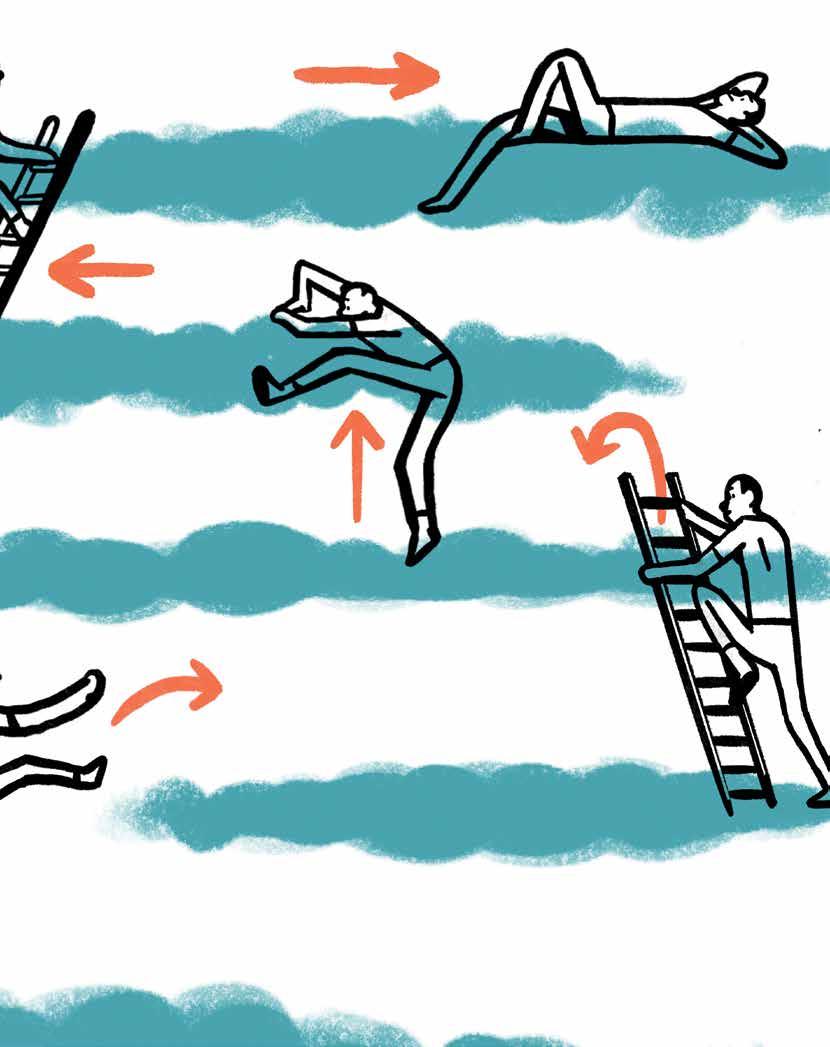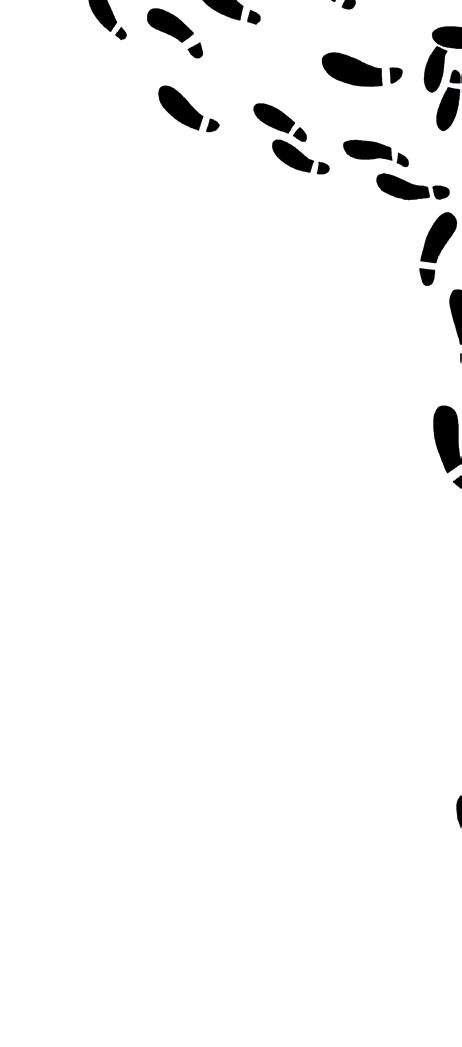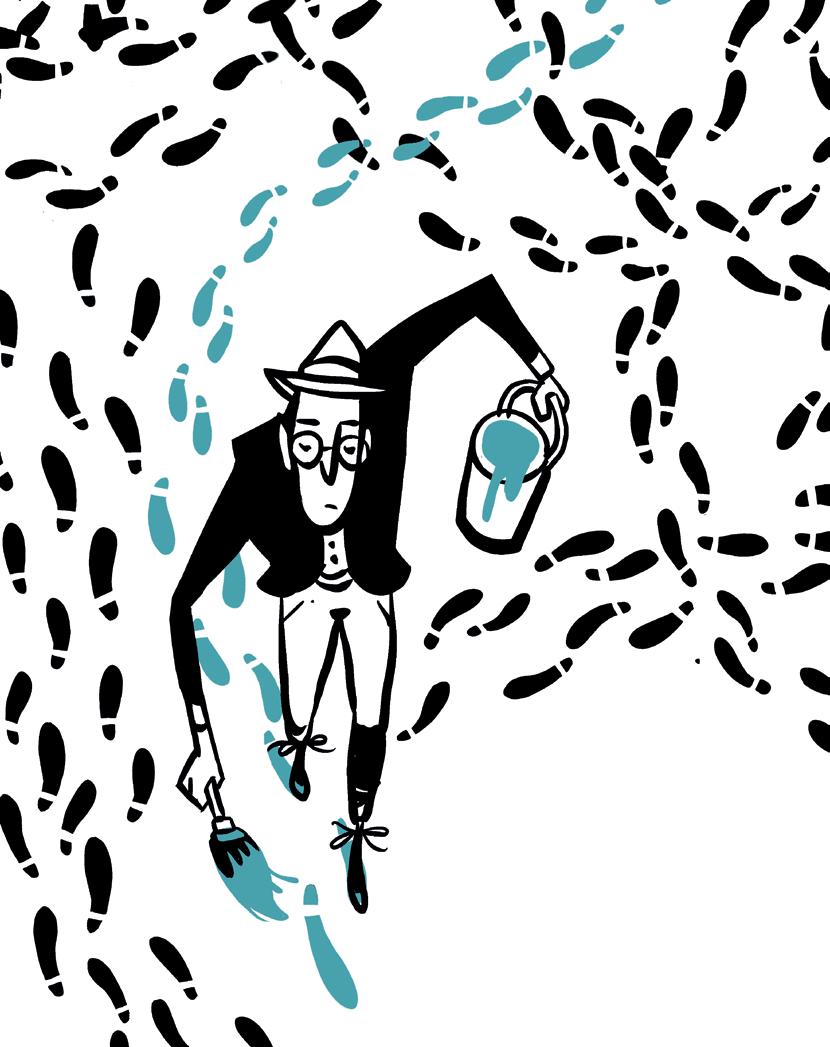
18 minute read
Thinking out of the box
When the product offer isn’t clear, change the way people think about it.
: Redondo
illustrations
In conversation with Romain Boulongne
Assistant Professor of Strategic Management at IESE Business School
What – or perhaps more to the point, how – is your target audience thinking about your products? It was while researching a French public investment bank for his dissertation that Romain Boulongne began delving into the cognitive processes at work in people’s minds when faced with ambiguous product offerings. In trying to figure out why uptake for a new loan product was so disappointing, he turned to psychology research on “categorization processes,” yielding practical insights for business strategists into how best to prime and prompt audiences so that ambiguous offerings are communicated and understood with greater clarity – and potentially greater social impact.
Tell us how you got started with your research.
For my PhD research, I wanted to continue to work on urban economic development, especially aimed at socioeconomically deprived areas, then officially known as zones urbaines sensibles (ZUS), nowadays termed quartier prioritaire (QP) or quartier prioritaire de la politique de la ville (QPV). Many of these disadvantaged areas are disproportionally made up of immigrants who often face religious and racial discrimination. You see this in some of Paris’s poorer banlieues (suburbs). So, I partnered with a public investment bank in France that had a real business problem: It had launched a promising new loan product aimed at entrepreneurs in disadvantaged areas. However, there were few takers. To figure out why, I had to take a step back. Why was this financial offering not reaching its target audience? People understood loans and interest rates, so what was it about this new product that made it more difficult for people to understand?
How did this lead you to study “categorization processes”?
In psychology literature, two main approaches are used to make sense of difficult or ambiguous offerings. The primary approach is the baseline: relating an offering to an existing prototype. That’s the easiest approach; we do it almost automatically. But what happens when there’s no prototype? That’s when we try the second approach: relating the existing offering to some ad-hoc or specific goal. This can dramatically change the way we think.
Let me give you an example. Think of a bird. What’s the first image that pops to mind? Usually, people will say a robin or a pigeon. But why not a chicken? As many psychology studies have shown, human beings tend to think of a bird’s most defining or prototypical characteristics first. So, flying is a quintessentially bird thing to do, and chickens are pretty terrible at flying. That’s the baseline.
Now what happens if I give you a goal prompt? Think of what you might have for dinner while you are thinking of a bird. That’s when a chicken is more likely to register.
Having a goal in mind can take us down a different cognitive path. “Eating” can prompt us to think about some secondary characteristics. And that is why goal priming can be extremely useful in business strategy and innovation, particularly when it comes to putting forward ambiguous offerings.
We saw this with smartphones. When the smartphone first came out, it was initially hard for customers to grasp what it was because there was no preexisting category for it. But by activating the
idea of a goal – thinking about what we can do with a smartphone, like watching videos or using a map for directions – suddenly what would be considered weird in one category can be evaluated and accepted differently in another.
Tell us how you tested prototyping and goal priming in your paper “Evaluating ambiguous offerings.”
My co-author and I conducted six experiments. Through these experiments, we found that, with a clear-cut offering, it’s better to activate prototype-based categorization and it’s detrimental to activate goal-based categorization. And vice versa: If an offering spans categories, is hard to classify or is ambiguous, then to get higher evaluations, it’s always better to prime audiences with a goal.
Our findings hold up in the realm of financial products (our original problem) as well as in the realm of a consumer product like a smartphone with more or less ambiguous features. For example, we ran an experiment using smartphones with a fixed processor speed (clear-cut) and variable speeds (ambiguous) and found that participants who were primed to think of how they would watch movies on the go (a goal) ended up giving higher evaluations to the variable-speed phone. Meanwhile, those who were primed with a prototype gave higher evaluations to the clear-cut offering.
Why is that?
Prototype-based categorization is easiest for us because we map what we are evaluating with something already stored in our minds. So, if we are evaluating a movie or a wine, if we know the category (genre or varietal), we know what to expect. And we tend to reward products that meet our expectations.
But when customers start to evaluate something ambiguous, thinking of a prototype is confusing. They may react negatively just because of that. In these cases, priming with a goal activates another cognitive mechanism that puts offerings in a more favorable light. Take another example: Amazon’s
Using a goal prompt can activate a new way of thinking
Alexa. What is it? A virtual assistant that looks like a speaker? Or a way of listening to songs while cooking? Framed that way, Alexa makes more sense.
What the goal prompts really do is relax the baseline assumptions that customers tend to rely on first and move them to another mental model. With the smartphone, using a goal prompt of watching movies is different enough from the prototype to activate a new cognitive process or a new way of thinking.
Who is this research most useful for?
There’s obviously something here for marketers, but more broadly it raises questions of strategy, including how to manage different product portfolios, how to introduce new products into markets, how to communicate to stakeholders and the key messages you want to put forward. When we dive into how customers or other stakeholders make sense of a firm or its core products, we can devise strategies that lead to better evaluations.
What next?
I’m currently looking at a third well-researched way to prime audiences: via analogy, using comparisons to activate more favorable evaluations in products that are in the sweet spot of being neither too novel nor too familiar. For example, when Lime launched its electric-scooter service in European cities, they presented themselves as “the Uber of scooters” to generate an analogy between a well-known app-based transport service and themselves. For this paper, we present a model to map which prompts work best in different circumstances. In short, we recommend priming
audiences with prototypes for classic products, analogies for semi-novel ones, and goals for novel or ambiguous ones (see takeaways).
Going back to the bank, what did they make of your findings?
They found them very helpful as a way to reframe their offerings. I should note that I continue to collaborate with them, including in research on impact investing, which is about, from the investor’s perspective, making both social and financial impact. In our case, we look at impact investing in France’s most disadvantaged areas that have been underserved or discriminated against, and we investigate whether financing ventures in these zones brings about more positive impact per euro invested. We find that granting loans to firms based in disadvantaged areas, compared with investing in otherwise similar ventures in wealthier areas of the very same cities, leads to more and better jobs, and also greater relative financial performance.
With our findings, we hope to encourage more lending and investments in disadvantaged urban areas where many ventures have been overlooked by traditional financial institutions. This is in line with work by my IESE colleagues Pascual Berrone and Joan Enric Ricart, who look at the importance of financing for sustainable urban development in their Cities in Motion project. It also contributes to research on social inclusion and investment, an area investigated by another IESE colleague, Sampsa Samila, who looks at the positive interplay between venture capital and ethnic diversity.
How does this relate to your work on categorization processes and ambiguity?
Apart from the involvement of the bank, it doesn’t relate exactly, yet the lines of research are related in my mind by the fact that the impact investing research looks at firms that are located at the periphery – literally – and consequently face discrimination from external evaluators. They are not the prototypical firms you would expect, and they are stigmatized. I hope my research will help to remedy that.
Takeaways
How are your audiences thinking? Bear these in mind:
Prototype prompts are the least taxing and most frequently used. Employ this baseline when a product doesn’t deviate far from expectations.
Goal prompts are the most taxing mentally and they backfire when used inappropriately. In fact, goal prompts lead to significantly lower evaluations if the offering would have been easy to grasp without them. For higher evaluations, employ goal prompts that are intentionally distinct from the baseline when a product is unknown or hard to make sense of.
Analogy prompts (comparisons to something familiar) garner the highest evaluations for intermediately novel offerings, and that combination is optimal compared with any prompts for either non-novel or very novel offerings.
read more: “Evaluating ambiguous offerings” by Romain Boulongne and Rodolphe Durand is published in Organization Science (2021). Boulongne also has these papers in the works: “Impact investing and the fostering of business ventures’ financial performance and social impact in disadvantaged urban areas” and “Strategizing categorization processes to the firm’s advantage.”
4 principles to manage your career for the long term
By Dorie Clark
Just as CEOs jeopardize long-term growth by only focusing on quarterly profits, we risk falling into the same trap in our personal and professional lives. Follow these tips to break the short-term orientation, see the big picture, and tap into the power of small changes to transform your life and career.
: Raúl Arias

illustrations
We all know it’s advantageous to be a long-term thinker. After all, we see the mayhem that results from short-term mindsets, from companies failing to innovate (Kodak) to leaders who are incentivized to cut corners to hit their numbers (Wells Fargo). The lure of short-term thinking may be more visible at the corporate level, but it’s just as perilous in our own lives and careers.
Over the past several years, I’ve researched the question of how to embrace strategic thinking in a world that so often pushes us toward instant gratification and immediate results. Resisting the easy lure of likes and retweets requires leaning into the hard choices. I suggest some principles for longrange success in my new book The Long Game: How to Be a Long-Term Thinker in a Short-Term World. Here are four of my favorites, which I hope can be helpful to you as you chart your career path.

1. Expand your horizons
One of the forces shaping our career decisions is the approval of others. When our professional choices earn nods and accolades from people in our field or industry whom we respect, it gives us an immediate sense of validation. That’s great, but the danger of only ever doing this is that it leads to short-term payoffs, rather than achieving our long-term ambitions. We have to make a conscious choice to take the long-term view.
A few years ago, I met T.J. Wagner. After serving in the U.S. Army for over seven years, he decided to do an MBA at IESE. Between leaving the military and starting his MBA, he had nine months to spare. Transactional, short-term thinking would tell him to use that time to do a corporate internship so he could bolster his résumé and build connections before business school.
But he did something different: He went off and learned to sail in Malaysia and Thailand. After passing his skipper exam and getting his license, he spent the summer skippering yachts in Croatia and Greece. Some might view this as frivolous: How is this going to help you right here, right now? But sailing didn’t become a sidenote: At IESE, he took the initiative and became head of the school’s sailing club. Over the course of his two years at IESE, he teased out the racers like him hidden among the class ranks and engaged in team-building with internationally diverse crews. He built long-lasting relationships with alumni and peers from sailing clubs at other business schools whom he met at European regattas.
When it comes to relationship building, most of us are good at short-term networking, but how often do we engage in “infinite horizon” networking
– consciously putting ourselves in places where we are exposed to ideas and possibilities that never would have arisen otherwise?

Why not write down at least two specific ways that you might personally expand your “infinite horizon” circle? Perhaps it’s getting involved in an alumni association, cohosting a dinner or virtual cocktails with a friend in a different industry, reconnecting with a long-ago friend, or attending an ideas conference. These creative bets may take a while to pay off but such relationships and involvements can be the most transformative.

2. Carve out 20% time
One of the reasons we hesitate to take chances or explore new avenues in our professional lives is that, so often, the conversation around reinvention is all or nothing. In writing my first book, Reinventing You, I came to realize how pernicious this implicit frame is. It prevents many people from taking action because, quite sensibly, they are wary of “taking the plunge,” “leaping and the net will appear,” or any other potentially fatal metaphor.
Instead, in The Long Game, I lay out a different possibility: 20% time. Invented by 3M (as 15% time) and popularized by Google in its present form, 20% time is the idea that you should devote a fifth of your time to new, experimental ideas that may not pan out but could be vastly rewarding if they do. (Google News and Gmail were two innovations born of employees’ 20% time.)
This is a powerful idea not just for companies but for all of us. Just as most financial advisers counsel us to have a mix of securities to mitigate our risk, we should do the same with our careers. Too often, we overindex on one security (our day job), and if it works out well, that’s great. But if it doesn’t – if we get laid off, or our industry changes, or we somehow get sidelined or simply decide we would rather do something else – we are left in a precarious position. Meanwhile, if we have steadily been building up a small part of our equity (our time and effort) in another area, it can be a powerful hedge against change and uncertainty, and a way to experiment in new areas with low risk.
In The Long Game, I profile a Google employee named Adam Ruxton who leveraged his 20% time
to volunteer for a project with X, Google’s so-called moonshot factory. Through the relationships he built, he positioned himself to land a full-time job with X when it needed a new marketing staffer.
Adam’s experimental time was devoted to different projects inside his company (and that’s appropriate if you’re working on company time). But you can create your own 20% time carved out of nights and weekends, and pursue entrepreneurial ambitions or new hobbies that might yield interesting outcomes.

In my book Entrepreneurial You, I profile Lenny Achan, a technology-obsessed nurse who, in his free time, developed two smartphone apps. When his boss found out about his sideline, instead of being angry as Lenny feared, he was thrilled because he realized Lenny must be truly passionate about emerging technology in order to invest so much of his free time. He tapped Lenny to lead social media for the hospital, and eventually Lenny rose to become the head of all hospital communications.
Thinking through how we choose to deploy our own 20% time can lead to enormous personal and professional growth, as well as unforeseen opportunities.
3. Think in waves
One of the most common problems I see in the executives and entrepreneurs whom I advise is a tendency to keep doing what they are already good at. Of course, that makes sense: Who wants to abandon a winning formula? But if you feel like you’ve hit a career plateau or you’re not advancing as fast as you feel like you should, the problem is often failing to recognize that it’s time for a new challenge. In The Long Game, I explain my theory of Career Waves – namely, that there are four phases we need to cycle through as we develop in our careers: Learning, Creating, Connecting and Reaping. Each is valuable and appealing, but if we get stuck for too long in one phase and fail to move on, our career progress will always be limited.
learning. Our careers start with the Learning phase. Early on, we don’t have any idea about how our industry works, how the business world works, how to manage others and so on. Reading copiously, taking professional development courses and absorbing lessons from mentors around us is paramount. Eventually, though, you need to start contributing and paying it forward: It’s time to enter the next phase.

creating. In the Creating phase, you’ve developed your own ideas and perspective. By now, you have wisdom and experience to share, so it’s incumbent upon you to do it, both to help others and also because it’s a way to demonstrate the value you can bring to the table. When others recognize the quality of your insights, you’re far more likely to be tapped for promotions and other opportunities. But it takes a village to build a career, which brings us to the Connecting phase.
connecting. Building relationships may be easier for some (such as extroverts) than for others, but all of us have to cultivate connections with a professional community. This helps to hone our thinking, as trusted colleagues can help us sharpen our ideas and identify the most promising ones to follow. They can also help amplify those ideas, serving as our ambassadors.
reaping. On the surface, it might seem like Reaping is the final destination – the chance to savor our hard-earned success. And to a certain extent it is. But as the legendary executive coach Marshall Goldsmith told me, “[People will say] ‘I used to be the CEO. I used to be the football star.’ You can’t ever be happy in life with a thing that used to be.” To combat this, you have to keep reinventing yourself, to circle back to the Learning phase, so you can embark on something new and meaningful. Goldsmith himself has done this, by creating a legacy project in which he vows to teach up-and-coming coaches everything he knows for free, with the pledge that participants will one day pay it forward. (I have been a part of this initiative since 2017.)
All of us need to recognize the cyclical nature of our professional lives. We can’t afford to rest on our laurels or stagnate. Instead, it’s a continuous process of moving forward and, as T.S. Eliot would have it, “to arrive where we started and know the place for the first time.”
4. Embrace a 7-year horizon
In 2011, Amazon’s Jeff Bezos told Wired magazine, “If everything you do needs to work on a threeyear time horizon, then you’re competing against a lot of people. But if you’re willing to invest on a seven-year time horizon, you’re now competing against a fraction of those people, because very few companies are willing to do that. Just by lengthening the time horizon, you can engage in endeavors that you could never otherwise pursue.” Such endeavors include Alexa and Amazon Web Services, which took time to develop and achieve scale.
The same is true in our own careers. We have all heard a million times that success never happens
overnight, but we have no clarity about how long it does take, so we risk becoming frustrated and quitting too soon when things don’t materialize in short order. If we can be diligent about investigating what success in a given realm actually takes (at least on average), then we will have far more realistic expectations to measure our progress against. Coupling this with the patience to wait for results, sometimes for years, is a powerful combination.
As venerable as long-term thinking is, it’s rarely practiced in our society; the pressures against it are great. Yet by cultivating the discipline to go your own way, experiment fearlessly, embrace risk (but not too much) and expand your time horizon, you will make yourself invaluable to others – and have the opportunity to create the career and life you want.
The author
Dorie Clark has been named one of the Top 50 business thinkers in the world by Thinkers50, and was recognized as the #1 Communication Coach in the world by the Marshall Goldsmith Leading Global Coaches Awards. A consultant and keynote speaker, she teaches executive education at Duke University’s Fuqua School of Business and Columbia Business School.
read more: This article is adapted from Dorie Clark’s new book The Long Game: How to Be a Long-Term Thinker in a Short-Term World (Harvard Business Review Press, September 2021). Learn more and download your free Long Game strategic thinking self-assessment at https://dorieclark.com/longgame.
From her website you can also find out more about her previous books: Entrepreneurial You (2017), a blueprint for monetizing your expertise to become an independent professional; Stand Out (2015), on finding your breakthrough idea and building a following around it; and Reinventing You (2013), on how to develop a compelling personal brand.
IESE alumni can access her webinar “Reinventing you: What to do when it does not work out,” delivered in April 2021 as part of the Career Management Series.






